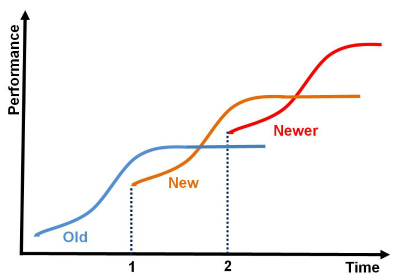Types of innovation - Choosing where to innovate
A number of frameworks have been used to look at types of innovation. Generally these approaches for categorizing innovation consider the sources of innovation from past successes or attempt to identify where to look for new innovation in the future. The variety of innovation types demonstrates that the benefits of innovation are not limited to new product development.
Categorization also helps in the measurement of innovation, allowing for performance comparison and evidence based choices that can guide where improvements or advances might generate the most return for a given investment. This is sometimes referred to as the "Return On Innovation."

Different classification models used for discussing innovation types
Alternative frameworks for innovation lead to differing types of innovation based on the objectives and approach inherent in the framework. Here are some well known examples that can be helpful with managing innovation.
- In Geoffrey A. Moore's book, "Dealing with Darwin: How Great Companies Innovate at Every Phase of Their Evolution", innovation is considered in the context of the category life cycle, with category being the product or service term used by customers that distinguish what it is they are buying. In this context, Moore defines innovation types consisting of:
- Disruptive;
- Application;
 Product;
Product;- Platform;
- Line-extension;
- Enhancement;
- Marketing;
- Experiential;
- Value-engineering;
- Integration;
- Process;
- Value-migration;
- Organic; and
- Acquisition.
- Doblin (a member of the Monitor Group) suggests types from industry patterns. These include innovation in:
- Business model;
- Networking;
- Enabling process;
- Core process;
- Product performance;
- Product system;
- Service;
- Channel;
- Brand; and
- Customer experience.
- In a approach that considers change impact or scope, common types are:
- Incremental innovation;
- Radical (or breakthrough) innovation; and
- Transformational ( or disruptive) innovation.
- In a similar manner, an alternative approach considers impact to current business, leading to categorization of innovation into:
- Cannibalization;
- Market creation; and
- Competitor disruption.
- Types of innovation can be determined by innovation source. Familiar examples are:
- Manufacturer innovation; and
- End-user ( or open-market) innovation.
- Where to focus leads to internal versus external innovation. This can sometimes be helpful in managing the level of investment needed.
- The Oslo Manual, developed jointly by Eurostat and the Organization for Economic Co-operation and Development (OECD) provides a framework to enable innovation measurement. The manual proposes innovation types of:
- Product (good or service);
- Process;
- Marketing methods; and
- New organizational method in business practices, workplace organization or external relations.
Using business decisions as an innovation framework
At Decision Innovation, we advocate using the business decision network as the framework for innovation. The business decision network exposes all the decisions creating value for the business, making it easy to see where innovation might create or enhance value for the business. Types of innovation are identified by the type of decision being made. For example, a target market decision would be the source of market innovation opportunities. Similarly, a brand strategy decision would lead to brand innovation opportunities.
The innovation frameworks above focus on different elements already included in the decision framework.
- Category lifecycle points toward which decisions in the business strategy are likely to generate value for a product or service category.
- Industry patterns suggests decision groups that might generate new value in a given industry.
- Impact or scope suggests the potential change impact innovative decisions can have on the business. Innovation in strategic decisions will have greater impact, while changes lower in the network are more likely to generate incremental value. In either case, the decision framework enables an evaluation of potential impact, including positive or negative changes to current markets, profits, or competition.
- Internal or external focus is a consequence of which strategic decisions are considered when innovating. For instance, choice of a strategic partner would imply an external focus.
 Innovation measurement is enabled by the decision network where outcomes can be traced to the sources of innovation, the decisions that created new or sustained value.
Innovation measurement is enabled by the decision network where outcomes can be traced to the sources of innovation, the decisions that created new or sustained value.
When using a decision network as an innovation framework, each decision provides the basis for creating ideas focused on a real business problem, making each idea a potential innovation.
Choosing where to innovate
Finding new opportunities to innovate and create value is often a routine expectation of research and development. However, the types of innovation exposed in the frameworks above suggest multiple sources for innovation across the business, function, organization, or industry.
Ultimately, value is created in the decisions made for the business. A decision framework provides the complete environment for innovation. It simultaneously identifies the type of innovation, along with the context to evaluate the potential value, impact and scope needed to make an effective investment choice.
More about specific innovation types
Business model innovation
Foundational strategic changes that can create new value.
Incremental innovation
Manage incremental innovation to find low risk opportunities for business growth.
Return from Types of Innovation to Innovation Management Home

